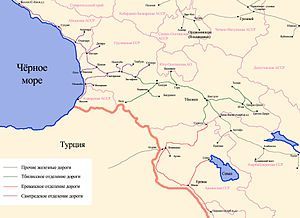Transcaucasus Railway

The railway in 1967—1991
|
|
| Locale | |
|---|---|
| Dates of operation | 1871–1991 |
| Successor | TCDD, RZhD, IRIR, ADDY, GR, HYU, AKR |
| Track gauge | 1,520 mm (4 ft 11 27⁄32 in) |
| Headquarters | Tbilisi |
Transcaucus Railway (Russian: Закавка́зская желе́зная доро́га) was the first railway in South Caucasus.
It was funded by the Russian Empire as a strategic railway connecting the Black Sea to the Caspian Sea. The railway would allow the Russian army to have better control of Caucasia. Also with the Trans-Caspian railway, Russia could transport troops from Central Asia much faster. The railway operated as a private company between 1865–1922 and a subsidiary railway of the Soviet Railways from 1922-1991.
The railway started in 1865 at the port town of Poti on the Black Sea. The railway reached Zestafoni in 1871 and T'bilisi in 1872. A branch line was built to Kutaisi, branching from Brotseula, in 1877. In 1883 the railway was completed to Baku. Once the railway was completed to Baku, freight trains carrying oil went from Baku to Poti to be shipped to other cities in Russia via the Black Sea. During the Russian-Ottoman war from 1877–1878, the Russian Empire gained territory into Anatolia from the Ottoman Empire after defeating them during the Battle of Kars. This new territory included the fortress city of Kars. In 1887 a branch line was built to Tkibuli. In 1894 a branch line, splitting of at Khashuri, was built to Borjomi. Kars was a strategic city for the Russians in Anatolia, so in 1899 the railway built a branch line from T'blisi to Kars. The Transcaucasus Railway was connected to the rest of the Russian system in 1900, when the line from Baku to Makhachkala was completed. In 1902, a narrow gauge railway from Borjomi to Bakuriani was built to serve the skiing community in the region. In 1913 the railway was extended from Kars to Sarıkamış; the border of the Russian Empire and the Ottoman Empire at the time. When World War I broke out in 1914, the Russian Empire sided with the Allied powers while the Ottoman Empire sided with the Central Powers making the two empires enemies. After the Erzerum Offensive, Russia gained control city of Erzurum. To support campaigns further into Ottoman territory, a narrow gauge (750mm) railway was built from Sarıkamış to Erzurum in 1916 and later into Yeniköy during the same year. Russia had to stop fighting in the war because of the Russian revolution of 1917, that lead to the dissolution of the Russian Empire.
...
Wikipedia
